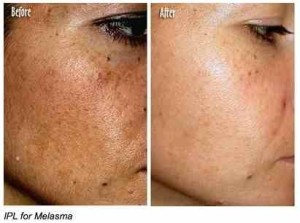The appearance of hyperpigmentation wrecks havoc on skin and is particularly apparent in the summer. This condition entails the abnormal darkening of the skin caused by excess melanin production below the skin’s surface. Hyperpigmentation appears as freckles, age spots, brown spots caused acne and melasma. Exactly how and why it appears depends on an array of factors, most notably ultraviolet (UV) light overexposure and hormonal fluctuations. Due to its unwanted cosmetic appearance, many seek hyperpigmentation laser treatments.
DETERMINING THE CAUSE OF HYPERPIGMENTATION
Hyperpigmentation occurs due to hormonal fluctuations, UV light overexposure and in some case may just be genetic. While freckles are usually easier to self-diagnose, the physical appearance of melasma and age spots are actually very close. However, it’s the presence of high levels and fluctuations of the hormones estrogen and progesterone that typically causes of melasma. For age spots, UV light overexposure and continued exposure are to blame. UV light also triggers the appearance of melasma and can make it worse if it’s not the initial causation factor. Genetics and certain medications also trigger melasma. Unfortunately, the exact cause of melasma remains unknown.

A consultation with a board-certified dermatologist will guide you through the options for hyperpigmentation laser treatments, such as Spectra. Image courtesy of www.realself.com*
Freckles are similar to melasma in that UV light exposure and genetics play a role. However, they typically appear in younger individuals and remain throughout adulthood. The appearance also worsens with UV light exposure.
For hyperpigmentation laser treatments, the procedures target melanin production. Melanin production acts like natural sunscreen for the body when exposed to UV light. Melanin is pigment in the epidermis that gives your skin its natural color but UV light accelerates the production of melanin. If within normal boundaries, melanin creates a tan to protect skin from UV rays. With too much melanin, hyperpigmentation occurs in blotches. Hyperpigmentation laser treatments work to restore overactive melanin production regardless of its cause.
What to look for:
- Freckles: small, brown dots; evenly distributed; closer to the surface
- Melasma: concentrated brown splotches on the cheeks, forehead, upper lip or jaw; deeper layers of the dermis
- Age spots: brown or gray splotches on the face, chest and hands
HYPERPIGMENTATION LASER TREATMENTS TO HELP
Hyperpigmentation laser treatments work by eradicating organelles that contain the extra melanin. The body absorbs organelles from the skin and then eliminates them from the body. Hypopigmentation may occur after, which is when the skin becomes lighter than usual. The skin is then restored to a more even tone. Spectra is the first Q-switched Nd:YAG laser cleared for the treatment of melasma. It also works incredibly well on age spots. Lutronic’s Spectra has four modes, with the 1,064-nanometer wavelength working to eradicate uneven skin tone with hyperpigmentation laser treatment.
Dr. Umar has helped thousands of Los Angeles residents achieve radiant, beautiful skin at FineTouch Dermatology. If you are concerned about hyperpigmentation, schedule a free consultation with his office. He will guide you on the best methods to address your hyperpigmentation issues.
